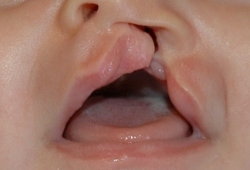Summary
Definition
病史和体格检查
关键诊断因素
- bilateral cleft lip ± palate
- unilateral cleft lip ± palate
- isolated cleft palate
- microform cleft lip
- isolated submucous cleft palate
- positive prenatal ultrasound
其他诊断因素
- difficulty feeding
- poor weight gain
- airway obstruction
危险因素
- genetic predisposition
- anticonvulsant drugs
- maternal tobacco use
- maternal alcohol consumption
- folic acid deficiency
诊断性检查
首要检查
- audiogram
- genetics consult
需考虑的检查
- auditory brain stem response (ABR) test
- vertebral spine x-rays
- renal ultrasound
- fluorescence in-situ hybridization (FISH)
- ophthalmic examination
治疗流程
complete cleft lip and palate
isolated cleft palate
isolated cleft lip
撰稿人
作者
Travis T. Tollefson, MD, MPH, FACS

Professor and Director
Facial Plastic and Reconstructive Surgery
Otolaryngology - Head and Neck Surgery
Cleft and Craniofacial Team
University of California Davis
Sacramento
CA
利益声明
TTT has received an honorarium and reimbursement for travel by the AO Foundation for teaching on a facial trauma course. TTT serves on the American Board of Otolaryngology and the American Board of Facial Plastic and Reconstructive Surgery, and receives a royalty from Thieme publishing for the textbook Complete Cleft Care. TTT is an author of studies referenced in this topic. TTT serves as editor-in-chief of the journal “Facial Plastic Surgery and Aesthetic Medicine.
David A. Shaye, MD

Instructor
Facial Plastic and Reconstructive Surgery
Massachusetts Eye and Ear
Harvard University
Boston
MA
利益声明
DAS has received an honorarium and reimbursement for travel by the AO Foundation for teaching on a facial trauma course.
同行评议者
Jordan N. Halsey, MD
Pediatric Plastic and Craniofacial Surgeon
Assistant Professor of Plastic Surgery
Johns Hopkins University
Assistant Professor of Plastic Surgery
University of South Florida
Tampa
FL
Disclosures
JNH declares that he has no competing interests.
Peer reviewer acknowledgements
BMJ Best Practice topics are updated on a rolling basis in line with developments in evidence and guidance. The peer reviewers listed here have reviewed the content at least once during the history of the topic.
Disclosures
Peer reviewer affiliations and disclosures pertain to the time of the review.
References
Key articles
Veau V. Bec-de-lièvre; formes cliniques - chirurgie. Avec la collaboration de J Récamier. Paris, France: Masson et Cie; 1938.
Wyszynski DF, Beaty TH, Maestri NE. Genetics of nonsyndromic oral clefts revisited. Cleft Palate Craniofac J. 1996 Sep;33(5):406-17.Full text Abstract
Royal College of Paediatrics and Child Health. Palate examination: identification of cleft palate in the newborn. Oct 2014 [internet publication].Full text
American Cleft Palate-Craniofacial Association. Parameters for evaluation and treatment of patients with cleft lip/palate or other craniofacial differences. Jan 2018 [internet publication].Full text
Boyce JO, Reilly S, Skeat J, et al. ABM Clinical Protocol #17: Guidelines for breastfeeding infants with cleft lip, cleft palate, or cleft lip and palate-revised 2019. Breastfeed Med. 2019 Sep;14(7):437-44.Full text Abstract
Cutting C, Grayson B, Brecht L, et al. Presurgical columellar elongation and primary retrograde nasal reconstruction in one-stage bilateral cleft lip and nose repair. Plast Reconstr Surg. 2012 Sep;130(3):659-66. Abstract
Reference articles
A full list of sources referenced in this topic is available to users with access to all of BMJ Best Practice.

Guidelines
- Parameters for evaluation and treatment of patients with cleft lip/palate or other craniofacial differences
- Palate examination: identification of cleft palate in the newborn
More GuidelinesLog in or subscribe to access all of BMJ Best Practice
Use of this content is subject to our disclaimer